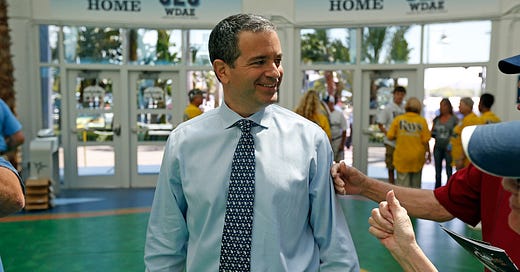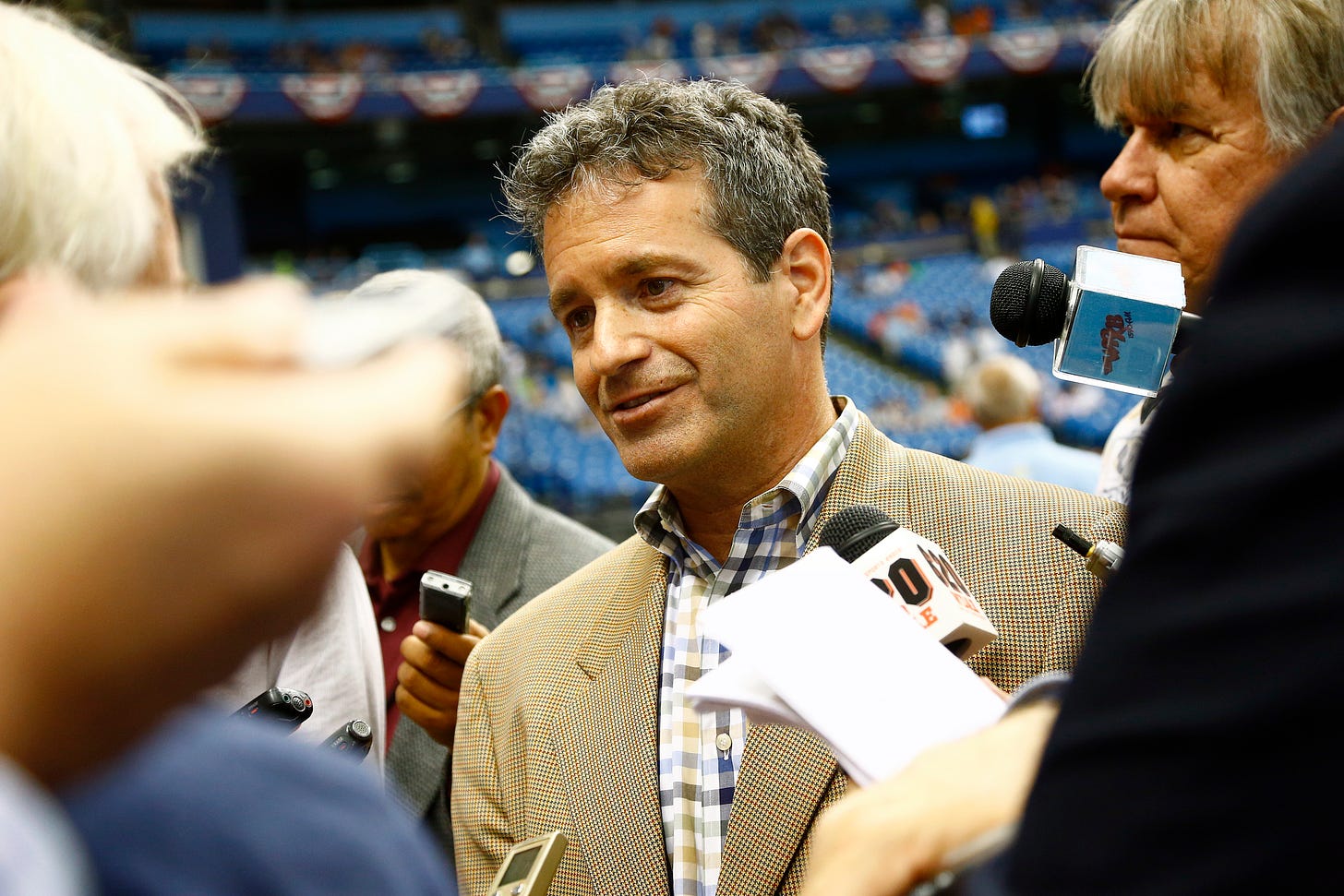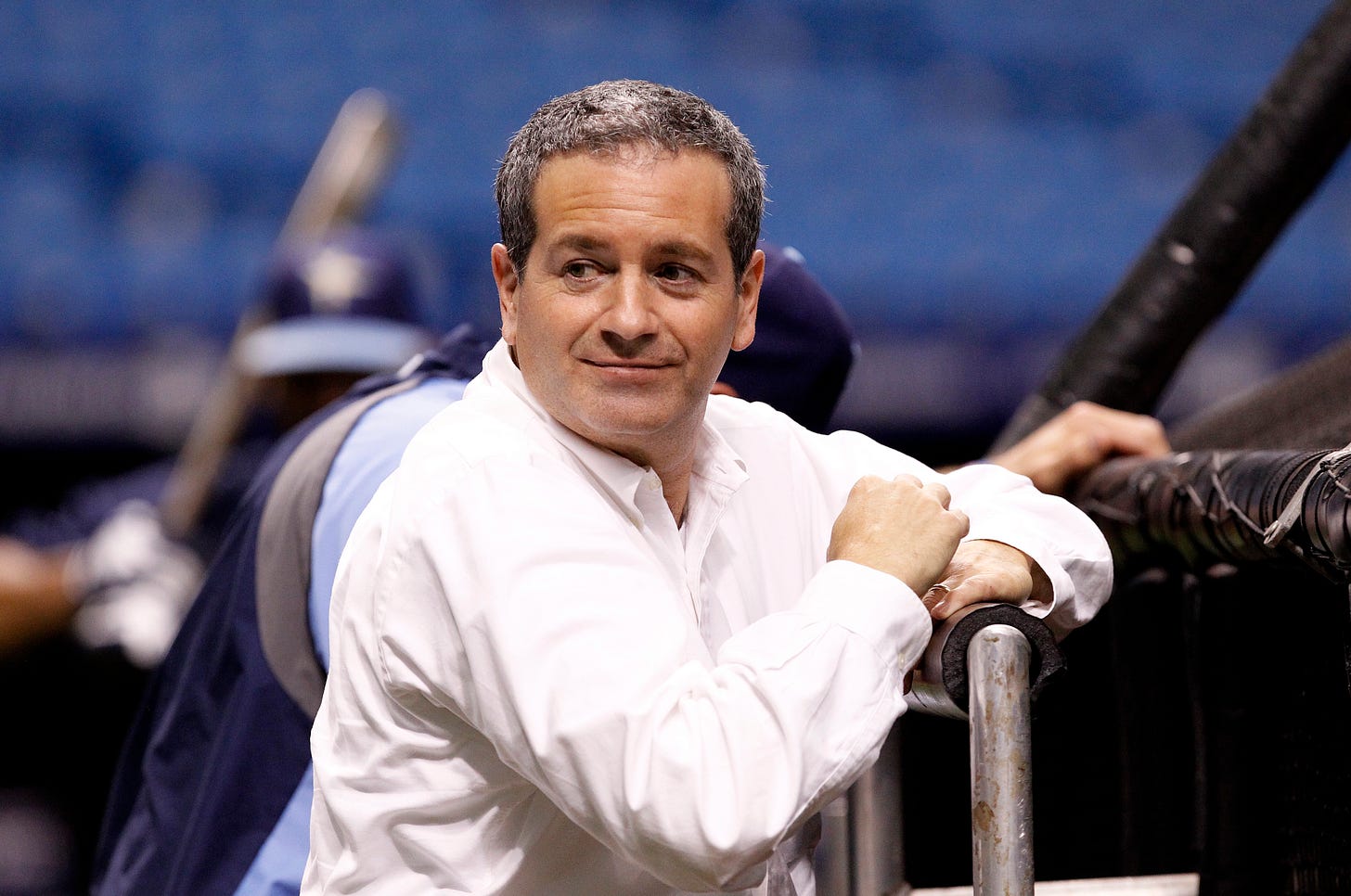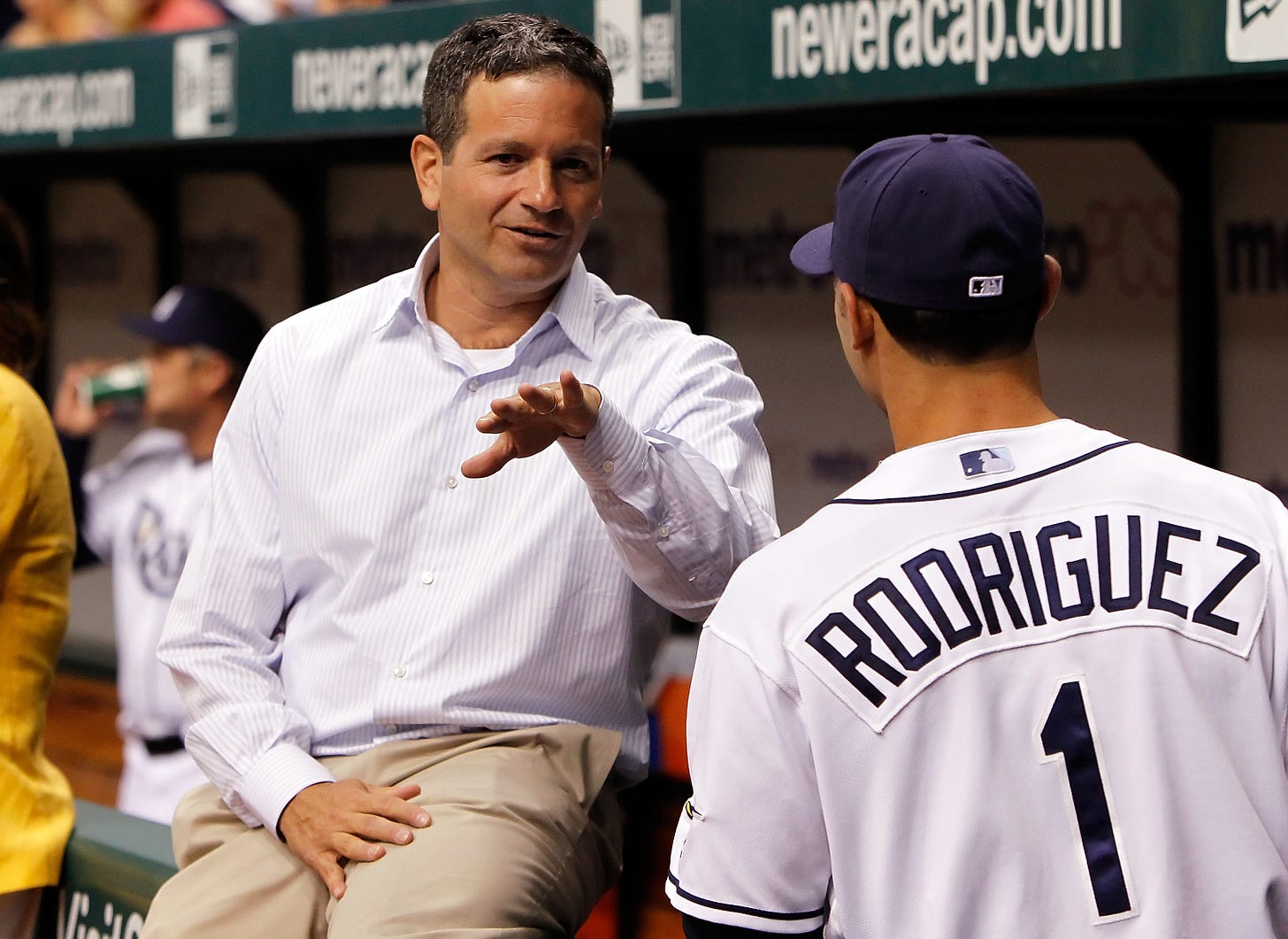Give Tampa Bay Rays' Owner Stu Sternberg Credit For This.....
If It Wasn't For Stuart Sternberg, Would Tampa Bay Have Had Rays Baseball For This Long?
As the sun rises over Tampa Bay on a chilly but mild January morning, it begins another day in the longest stadium battle in modern American sports history.
Major League Baseball has called the Tampa Bay region home since announcing the franchise back in March of 1995 when Bill Clinton was in office, cost of a gallon of gas was $1.15, and Hootie And The Blowfish debuted. The Tampa Bay Devil Rays began playing baseball on March 31, 1998 before a crowd of 45,369 fans at Tropicana Field, which is still the record attendance for a single Tampa Bay Rays baseball game at “The Trop.”
Through the years the capacity has decreased, winning has increased, payroll has never risen to the levels of their divisional rivals, and attendance has consistently finished in the bottom three of the American League for fourteen straight seasons.
Current principal owner Stuart Sternberg purchased the controlling interest in the Tampa Bay Devil Rays in November of 2005 following a record of 518-775 in the first eight seasons of the franchise finishing last in all of them. Sternberg rebranded the team to the Tampa Bay Rays in 2008 and since then has two World Series appearances, four American League East championships, and a total of nine playoff appearances in seventeen seasons. The Rays were and still to this day are a model of how to win trying everything without spending on players to the likes of their American League counterparts.
However, how did we get here? How did we get to a place where success on the field meant less support through the gate? It’s a fact after the Tampa Bay Rays 2008 World Series appearance where 1.81 million fans came through the gates of Tropicana Field, attendance only increased by roughly 63,000 total fans the next season.
Maybe Stu Sternberg knew the writing was on the wall before we all ever knew what was to come?
“If you look beyond our performance on the field these past few years, you’ll find a franchise that cannot continue as it currently exists. A Major League Baseball team’s ability to compete, and quite frankly survive, rests on its ability to attract fans and businesses to its ballpark”
“I spoke to many people throughout baseball and the Tampa Bay community. I elicited their opinions about what could be done to ensure Major League Baseball would become viable in this region. The unanimous response was that it was all about winning. Winning would change everything at Tropicana Field, that with a winning team on the field , an exciting and compelling team that comes to play each and every night the fans would fill the stands. Clearly that has not been the case.” - Stu Sternberg (June 21, 2010)
Nearly 15 years ago, Sternberg knew that baseball would be the toughest investment of his personal and professional life. He saw that the penultimate accomplishment of the sport was not enough to see large increases of fan support where it matters most, through the gates and turnstiles. The New York born and St. John’s University educated Sternberg rising from a degree in finance to a partner with Spear, Leeds and Kellogg to retiring in 2002 from being a partner with Goldman Sachs knew that the market for baseball in Tampa Bay would be the single biggest challenge of his life.
When Stu Sternberg took the podium and spoke those words about how a new ballpark is needed for a region that can’t support a Major League Baseball team with its current setup and Tropicana Field, he was retired, rich, and a family man living the life. He could have said years ago why bother fighting an uphill fight with my passion play of owning a Major League Baseball team, but he didn’t.
Following the Ybor City development where the Rays were allowed to talk to the city of Tampa about planning to stay in the region for the good of the franchise and area, Stu stood tall once it disappeared.
“I’m firmly committed to helping the Rays remain and thrive in Tampa Bay for decades and generations to come. Major League Baseball is a large part of what defines Tampa Bay as a major league region and I continue to be enthusiastic about finding a way forward.” - Stu Sternberg (December 11, 2018)
Sternberg’s continued efforts to find a way to keep baseball in the Tampa Bay region had him in discussions with a group in Montreal about a split season concept. An idea that would frankly give both the Tampa Bay region and the city of Montreal (who lost their franchise in 1994) a team to call their home.
Sternberg stood tall in front of a group of media, fans and business owners alike and said:
“We (St. Petersburg) are simply not well suited for a Major League Baseball team that needs to draw tens of thousands of people each of its 81 games to its ballpark. Our idea for Tampa Bay and Montreal to share the Rays. To be clear, this is not a staged exit. That thought has never entered my mind. This is not us even taking one glance towards a relocation to Montreal. I rejected that idea years ago, and I continue to reject it today. This is not a page out of a playbook to gain leverage, we have focused on this plan. We are focused on how the Rays can thrive here in Tampa Bay. This is about Tampa Bay keeping its hometown team and Montreal having one as well.” - Stu Sternberg (June 25, 2019)
The split season concept was met with massive criticism, fan outrage, and the shelf life for the plan was short and ended. However Sternberg who had stated that full season baseball in St. Petersburg would not work remained steadfast in his commitment to keep the team in the Tampa Bay region saying:
“The idea that it wouldn’t work completely in St. Petersburg or Tampa is not necessarily what our approach has been. We felt that the split season approach was a much better approach and something that ensured that it would work.” - Stu Sternberg (January 20, 2022)
Now over a full decade into the stadium saga engulfing all of Tampa Bay, the news that the city of St. Petersburg and the Pinellas County Commission had come to a framework of an agreement to keep the Rays in St. Peterburg as a part of a development of the Gas Plant District in St. Petersburg with over $600 million dollars of tax payer money going towards a $1.3 billion dollar stadium seemed to be the end of this ongoing fight to keep baseball in Tampa Bay.
“This is quite a momentous day for our franchise, our fans and the entire Tampa Bay region -- the Rays are here to stay in St. Petersburg,’’ Sternberg said in a statement. ‘’We look forward to building the best neighborhood ballpark in Major League Baseball, which will blend in beautifully with a world-class, mixed-use real estate project that honors the past and looks toward the future. We thank St. Petersburg Mayor Ken Welch, the St. Petersburg City Council and the Pinellas County Commission for their hard work. We look forward to working together with our partners for years to come on our shared vision for this transformative project.’’ - Stu Sternberg (July 30, 2024)
However mother nature and two hurricanes affecting the Tampa Bay region would be the latest impact on if the Rays stadium saga would conclude. As the roof of Tropicana Field was ripped off in the winds of Hurricane Milton, Sternberg remained steadfast that the votes on bonds following the massive amount of storm damage would not deter the future of the agreement between the team, city and county.
“Major League Baseball is here to stay,” Rays owner Stu Sternberg said during Tuesday’s news conference. “Right here.” - Stu Sternberg (September 19, 2024)
However like in all negotiations, things change. Delays in votes on public money happened. Elections happened, and because of the delays costs and timelines changed. No matter how the costs may or may not have changed, the feelings by Sternberg about the changes left a sour taste in his mouth.
“Last month, the County Commission upended our ballpark agreement by not approving their bonds, as they promised to do,” team owner Stuart Sternberg said. “That action sent a clear message that we had lost the county as a partner. The future of baseball in Tampa Bay became less certain after that vote. It’s a confluence of events and without the minds here coming together, (relocation) is not an unlikely conclusion.” - Stu Sternberg (Nov 16, 2024)
Today, it’s on the Rays to show by a March 31st deadline that they have met a checklist of obligations that would unlock public funding for the project, including whether the team has its share of $700 million to build the new stadium.
If not, the team would be in default and the agreements approved by St. Petersburg and Pinellas County last summer could unwind. This hurdle has once again tested Sternberg which led him to say:
“We’ll decide how we want to proceed at that point, well before that point,” said Sternberg, who on Monday attended Suncoast Tiger Bay’s State of the Bay event at the Vinoy Golf Club. “We have to make a decision, so we’ll have something by then.”
Asked what would help drive that decision, Sternberg said he didn’t know. “I’ll make sure our organization does what’s necessary to meet whatever conditions we need to meet,” he said. - Stu Sternberg via Tampa Bay Times (Jan 27, 2025)
It’s been almost 15 years since Sternberg first alerted the Tampa Bay community that the dream of housing a Major League Baseball team takes investment, not by just ownership but by the surrounding community and fans. Sternberg has been the single biggest target of criticism when it comes to the past, present and future of the Tampa Bay Rays franchise without question. His boyhood love for our national past time has kept baseball in the region for the last 15 years despite his early warnings of the challenges of keeping it.
The single biggest mission for a baseball owner is to provide a winning ballclub on the field. Sternberg has done that.
The single biggest mission for a baseball fanbase is to support it when times are good, and demand better when times are bad. Have the fans done that?
Stuart Sternberg deserves a lot of credit for continuing his push to keep baseball alive in Tampa Bay under his watch, building a winning ballclub with a unique but successful culture to surround itself with in spite of a fanbase that simply does not support it like it should. A fan base who likes to complain as another banner rises in the rafters. A fan base who likes to identify an enemy instead of recognizing greatness.
The mere fact that Stuart Sternberg continues to push to keep baseball in Tampa Bay for a fan base that doesn’t want him here is honorable and deserves credit. Without Sternberg, there may be no baseball in Tampa Bay and anyone that says otherwise is lying to themself. Sternberg has brought a winning culture to a region that long deserved it, and gets nothing but shame and displeasure from his own customers because he’s unwilling to just pony up the money to build a brand new stadium for a fan base with no guarantees that they will actually show up to.
Sternberg deserves more credit than he will ever earn from the area. For anyone to continue their sheer displeasure with an owner who’s attempting to get the absolute best deal to keep the MLB team in Tampa Bay long term is wrong and unjust. Stu Sternberg has been the single biggest champion for baseball in the Tampa Bay region, and that’s not without question. Anyone else in his position would have left a long time ago, and baseball may as well done that same.
Baseball is a business. Sternberg is a businessman, and he’s just doing business. The business of being the champion for baseball in Tampa Bay.









I’m mixed. In one way, he is a good owner to his team and willing try and even attempted to spend (see Friedman, Judge, and Ozuna). I do get irritated with his comments on attendance during high times like playoff games. I do not like how he is not more active in the community unlike Vinik and the Glazers.
Do I think baseball would survive without him In the Bay Area? Yes, due to the market size. Do I think it would do as well? No.
Stu is a business man but not cold or distant. He is willing to talk to any fan and take criticism. For that I respect him and admire his business tactics.
Stu is just really hard to get behind because he is a businessman and is in the business of building a thriving business, which happens to play baseball. He took a franchise and nearly increased its value by 1 billion dollars. During that time he has only watched a perennial loser because the third best team in baseball since ‘08 and the 4th best team since ‘20. For all his flaws, he is good. Period.